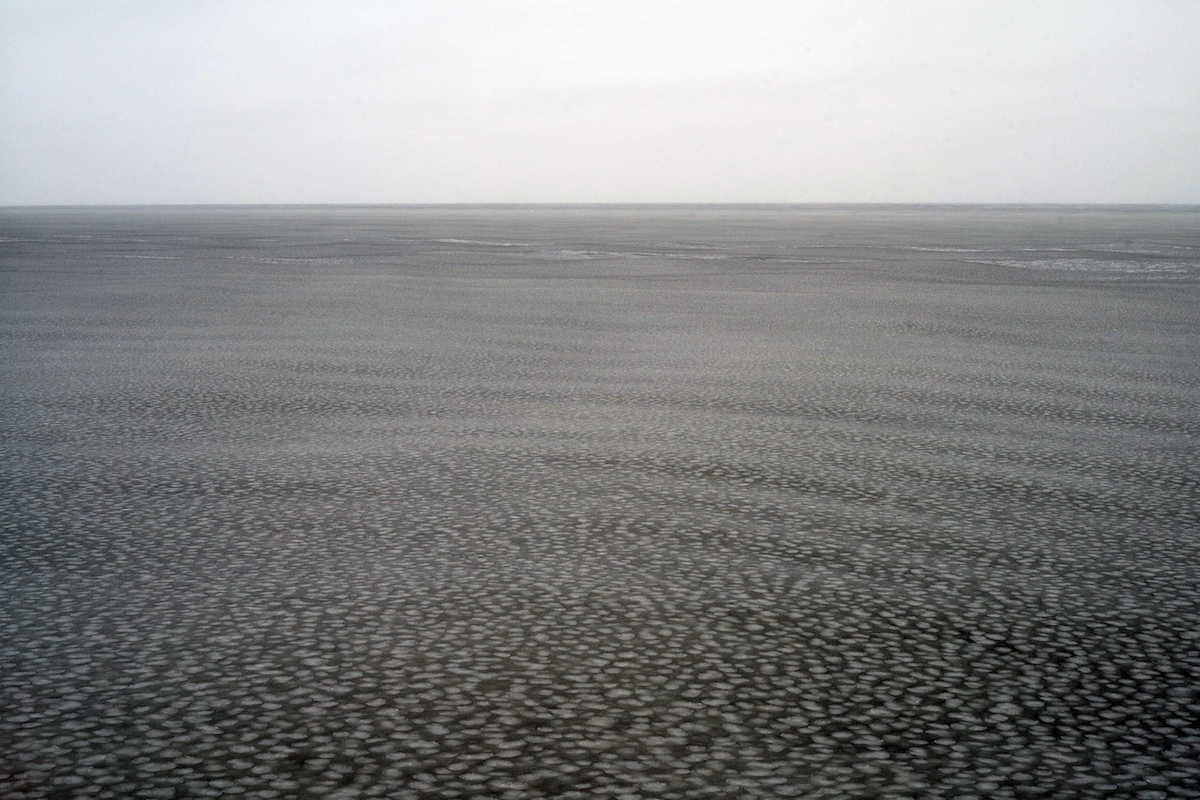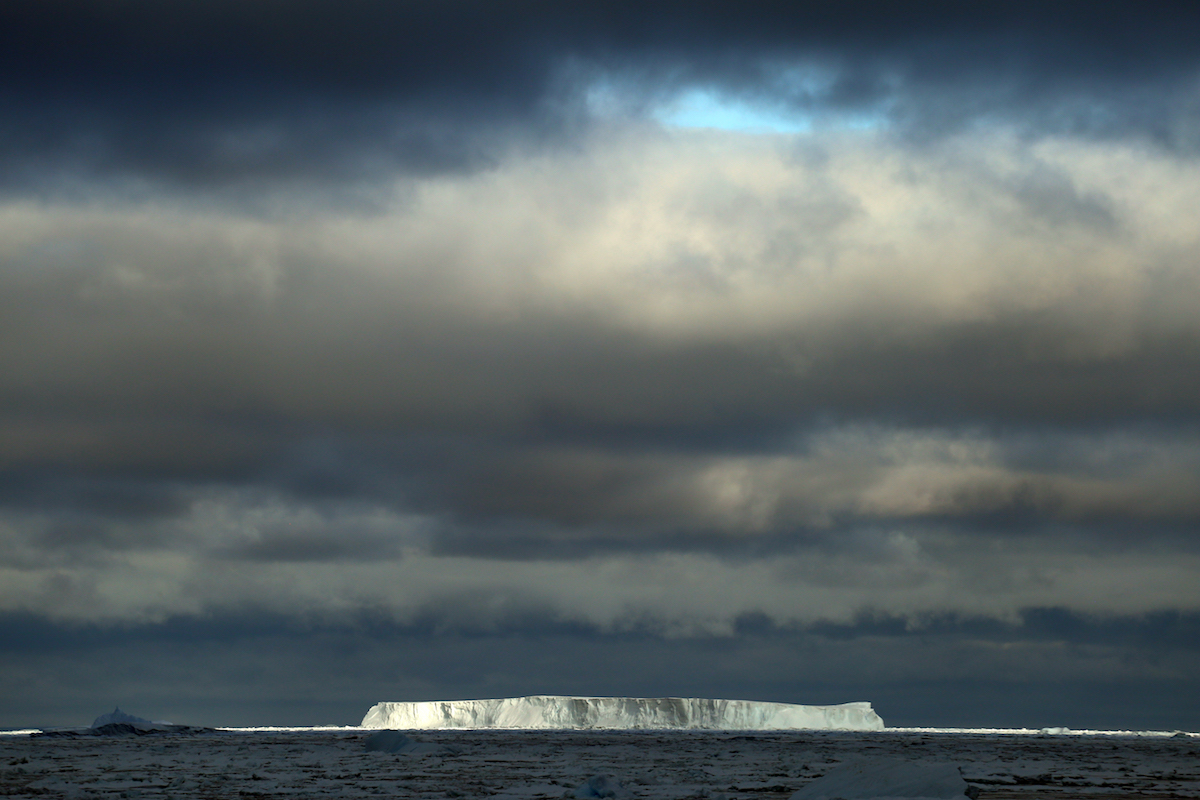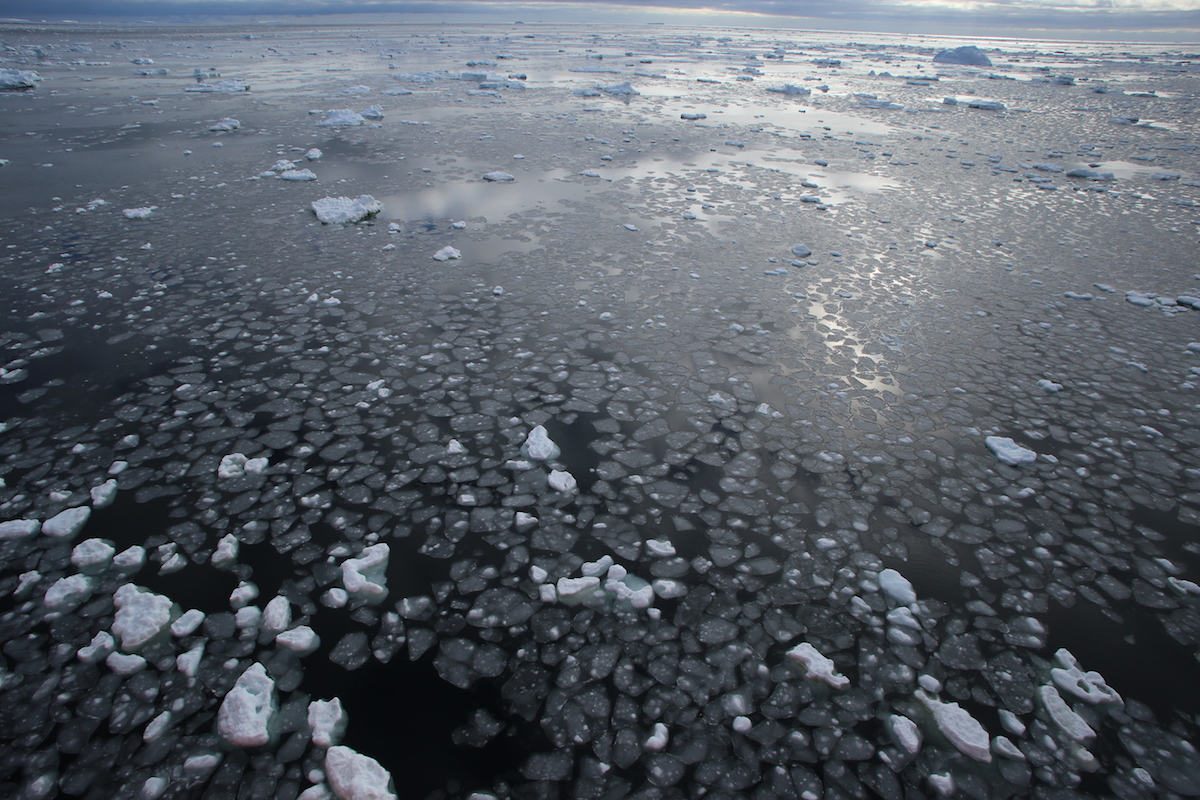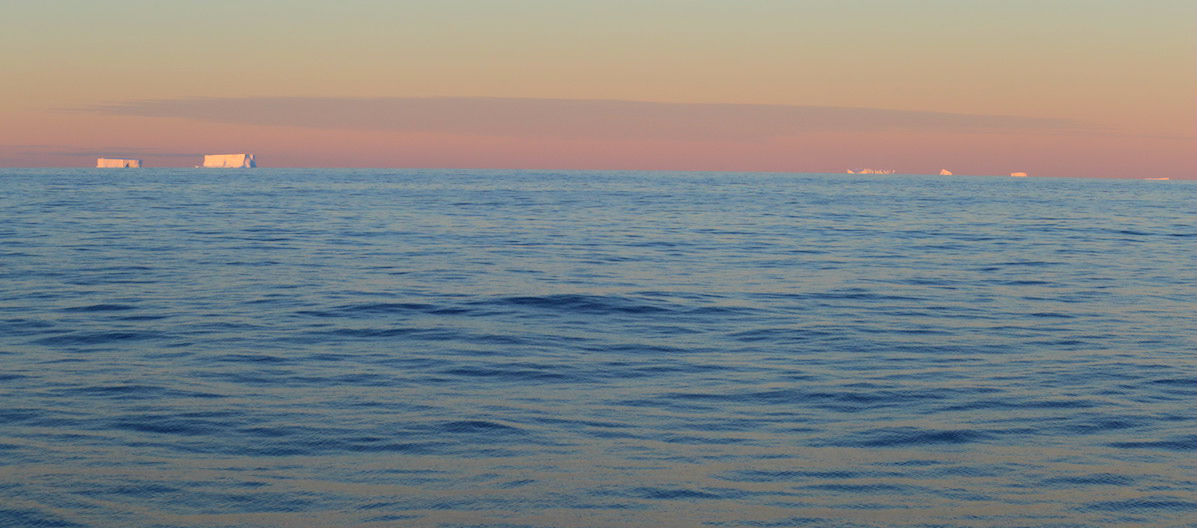Sometime last spring you receive a cryptic missive from your Program Officer at the National Science Foundation. It reads: An interesting opportunity has come up. Call me in the morning. Valentine. A strong wind blows all night, stripping the cherry blossoms from the trees. Your husband steals the covers and you, tucking the comforter under your right leg and turning over, slowly steal some of them back. After your shower you sit down to write and only then do you realize you missed a call.
When you return it, the phone rings not even one full time.
“Hello Elizabeth,” Valentine says.
You think it is either very good or very bad that she picked up so quickly.
Valentine tells you that she spent the previous day in a planning meeting for the International Thwaites Glacier Collaboration, a five-year program to study what is one of Antarctica’s most important and least understood rivers of ice. “This year they’re deploying an icebreaker to investigate. There’s one berth remaining and I recommended it be given to you,” Valentine says. Your heart rate rockets. Thwaites is one of the few glaciers you know by name. If Antarctica is going to lose a lot of ice this century, it is going to come from Thwaites. That’s because the glacier rests below sea level, making it vulnerable to warm water incursions that cause rapid melting from beneath, which, in turn, could force the entire glacial system into accelerated collapse.
Collapse is a word you hear often these days: as in Antarctica’s second-largest colony of emperor penguins recently collapsed and a recent United Nations report that says that “a million extinctions and ecological collapse” are on the way. In response, environmental activists around the world stage “die-ins,” a kind of political theater they hope illustrates how our actions have the power to both make and unmake the world of which we are a part. Meanwhile, Wall Street is betting that president won’t let stocks collapse and a Brazilian mining dam collapses, unleashing a tidal wave of toxic mud, killing more than 240 people. British steel and Venezuela are both “on the verge of collapse.” Together we teeter on the knife-edge of unprecedented change. And you, lucky you, collapse into your chair to talk to your Program Officer about your upcoming trip to Antarctica.
During the majority of the two hundred years since humans first saw the southern-most continent, women weren’t welcome.Thwaites alone contains three feet of potential sea level rise, and were it to wholly disintegrate it could destabilize the entirety of the West Antarctic Ice Sheet, causing global sea levels to jump four times higher. In terms of the fate of our coastal communities, this particular glacier is the biggest wild card, the largest known unknown, the pile of coins that could tip the scales one way or another. Will Miami exist in one hundred years? Thwaites is the answer. At least that is what many scientists think, which is also why Rolling Stone started calling it the Doomsday Glacier a couple years back. But no one has ever before been to Thwaites’ calving edge—no one knows just how rapidly the underside of the ice is melting—so many of the ideas we have about how this glacier will behave are a mixture of science and speculation, meticulous modeling married to our increasing fear.
 Photo by Elizabeth Rush.
Photo by Elizabeth Rush.
It is late spring in New England and the leaves on the oak trees are a tart, electric green. Classes have ended. You walk to the library with a watchful heart, steeped in the sense of setting out. Snake up the three flights of stairs to aisle 63A. First impressions: scant. The total number of books on Antarctica in the “history, geography, travel” section of the Brown University collection can’t total more than fifty. In order to begin to sink into this place through the experience of other people, the pool you will pull from is relatively small. Most of the books have foreboding names like The Worst Journey in the World, Deep Freeze, and Where the Earth Ends.
Back in your office, as you stack and inspect the nearly two dozen tomes you withdrew, you realize that only two of your selections were written by women. The introduction to Sara Wheeler’s Terra Incognito confirms your hunch. She writes, “Men have been quarrelling over Antarctica since it emerged from the southern mists, perceiving it as another trophy, a particularly meaty beast to be clubbed to death outside the cave.” You laugh out loud to no one but yourself. Think that her book has promise as you set it aside to flip open the second, penned by someone with whom you, at least, share the barest of affinities. You laugh again, but this time for a whole different set of reasons. Like half of everything ever written about Antarctica, Caroline Alexander’s The Endurance is, not surprisingly, a history of the famous failed Shackleton expedition. You should have known, since his boat that sunk in the Weddell Sea carries the same name as the book which lays before you now.
During the majority of the two hundred years since humans first saw the southern-most continent, women weren’t welcome. Rear Admiral James Reedy, the Commander of the United States Naval Support Force in Antarctica in the 1960s, refers to it as “the womanless white continent of peace.” When New York Times journalist Walter Sullivan wrote of the first all-women scientific expedition to the South Pole later that decade he described the undertaking as “an incursion of females” into “the largest male sanctuary remaining on this planet.” It wasn’t until 1974 that Alice McWinnie, the first woman to head an Antarctic research station, wintered-over there with her required “assistant” a biologist and nun named Sister Mary Odile Cahoon. In the intervening decades, many women who made it on board the ships and out to the research stations experienced harassment and assault while working in such a remote location. When one friend heard about your Antarctic expedition, she suggested taking personal defense classes; another wanted to know just how many other women would be with you on the boat. And a third sent you an article about a Boston University professor who was being investigated for taunting and degrading his female Ph.D. students alongside the glacier that carries his name.
All summer long you submerge yourself in the Antarctic canon and the desires of those who journeyed south to conquer a thin sliver of the continent of ice. Some books you cannot finish. Others leave you pleasantly surprised. By July you are growing bored. The same half dozen events––Scott’s death eleven miles from One Ton Depot, Shackleton’s miraculous return, Mawson shooting and eating his sled dogs––are woven into nearly every narrative account of the last continent’s history. Then one painfully humid day you read Ursula Le Guin’s short story “Sur” and enter an entirely new Antarctica.
In Spanish sur means south. South as in the singular goal of the “Heroic Age of Antarctica Exploration,” the quest to reach the southernmost land––a desire undeniably driven and largely dominated by countries from the global north for whom such folly was affordable. South as in Sir Ernest Shackleton’s personal account of the doomed voyage that would turn him into a legend. In Le Guin’s deft hands, the word and the world it describes take a radical turn. Her female, Latin American narrator begins, “Although I have no intention of publishing this report, I think it would be nice if a grandchild of mine, or somebody’s grandchild, happened to find it someday; so I shall keep it in a leather trunk in the attic, along with Rosita’s christening dress and Juanito’s silver rattle and my wedding shoes and finneskos.”
You stop reading and google, finnesko. Finnesko: from Norwegian, a soft-hide boot of tanned reindeer skin used for cold climate travel. As in what this woman wore on her feet when she went to Antarctica. Finnesko, a relic of exploration that now, in some mind-boggling turn, appears alongside a bunch of domestic bobbles. Sterling and animal hide, nested together in a chest on the top floor of a small suburban house in Lima. You feel the boundaries long built between two gendered ways of inhabiting the world blur a little. It is exhilarating and you’re only on the first sentence.
Our narrator, who does not have a name and therefore could be any of us, gathers with nine other women––one Peruvian, three Argentines, and four Chileans––in Punta Arenas in 1909. Together they cross the great Southern Ocean in a little steamship they name la vaca valiente (or the valiant cow); they raise a glass of Veuve Clicquot when they see their first iceberg, and another when they finally spot land. They encounter Scott’s famous Discovery Hut, inside which tins of tea have been left open, the floor scattered with stale biscuits––a polar bachelor pad. Teresa suggests cleaning it up and using it as their camp; Zoe wants to set it on fire. They do neither. Berta and Eva build an ice cave instead and name the central chamber Buenos Aires. In that cold home the women play banjo, carve ice sculptures, and plan their expedition to the pole. After months of preparation passed with the placing of supply depots and physical acclimation to the cold and the wind, the narrator and five others set out, dragging heavy sledges into the great silence, hoping to reach the southernmost spot on earth by foot.
As Sara Wheeler writes, “[Antarctica] was little more than a testing ground for men with frozen beards to see how dead they could get.”Like any other early explorer, they name, but in this case “not very seriously,” the land features they encounter. What Shackleton calls the Beardmore is briefly known as Florence Nightingale Glacier. Just south of it lies Mt. Bolivar’s Big Nose. On December 22, 1909, they become the first people to ever reach the South Pole. The women talk about leaving some kind of mark or monument, a flag perhaps, but decide there is no point. “[A]chievment is smaller than men think,” Le Guin writes. “What is large is the sky, the earth, the sea, and the soul.” You underline these lines. Instead of snapping photos to commemorate their accomplishment, the ladies drink a cup of hot tea and turn around.
The real climax comes later when, upon returning to the ice cave, the sledging party discovers that Teresa is pregnant. She goes into labor on the ice and screams herself “horse as a skua.” The women of the expedition tend to her, for many have labored themselves. After twenty long hours little Rosa del Sur is born and the women drink their last two bottles of champagne toasting to her. For the first time since you started researching the great southlands you sense that the story you just finished does not end when the text runs out. Instead of consecrating the closing of a possibility––anytime anyone is the first person to do something that means that no one can claim that title in the future––“Sur” celebrates the everyday act of giving birth and the host of unknowns and possibilities that attend the arrival of a new life. Long after you stop reading this, the story continues to unfold.
*
For the majority of human history no one glimpsed, let alone set foot, on Antarctica. There is no indigenous history to reference, no deep institutional knowledge of the ice. This is part of the reason why when we speak about that faraway continent we almost always talk in firsts. The first to cross the Antarctic Circle: Captain James Cook in 1773. The first to spend an entire year there: those aboard the R/V Belgica in 1898. Roald Amundsen is the first person to reach the South Pole in 1911, narrowly beating out Robert Falcon Scott, who will die in a tent some months later, just a few miles short of the food cache that would have saved him and the remaining members of his team from starvation. Their deaths––some say orchestrated by Scott in order to turn second place into something tragic and noble––along with the many others, racked up by those who sought the extraordinary privilege of marking our map’s largest blank space, will haunt a surprising number of the stories we tell about this place that we only recently began to know.
 Photo by Elizabeth Rush
Photo by Elizabeth Rush
Just a month before setting sail, you read about two men ––Colin O’Brady and Louis Rudd––who, according to the New York Times, “hope to conquer a continent that has become the new Everest for extreme athletes.” When you encounter this line, you will not lie, you are furious. So much time had passed since the initial exploring expeditions that remain so famed in Antarctic history––the planet deep now in the throes of the single largest geologic transformation human beings have ever witnessed––and yet mainstream journalism’s representation of Antarctica appeared, at least in this instance, not to have evolved a lick. For many, Antarctica remains a barren and brutal faraway place, unconnected to human civilization; as Sara Wheeler writes, “the continent was little more than a testing ground for men with frozen beards to see how dead they could get.” To pit O’Brady and Rudd against the elements is to continue to drive a wedge between man and nature, to make of this place that we know so very little about, into a hurdle, a hindrance, a problem. This language turns the more-than-human world into a place-holder, a poetic metaphor, a thing that must be overcome in order for the singular human being to rise up. Well, you think to yourself, I don’t buy it. The longer we talk about Antarctica as a place to be conquered the more we steal from ourselves the possibility that its transformations––the ones we have set in motion with our insatiable appetite for more––are, whether we like it or not, in the process of transforming us.
*
You’ll be the first to admit that gender essentialism comes up again and again when you’re thinking about Antarctica. As though the presence of womanhood infuses a sense of nurture into the Antarctic night, making the human communities on the last continent magically less competitive, warmer and more welcoming. Which of course reaches even deeper into our cultural baggage, unearthing the old idea that women are made for mothering, and not for adventure or intellectual pursuits. It is this kind of reductive thinking that is at the root of what kept women at arm’s length from Antarctica for much of the last two hundred years. But just as you are skeptical of making too much of an argument that sees women as inherently different than men, it is also equally hard to imagine that the sudden arrival of those whom our society calls women made no discernible impact on how we understand the only continent on earth so harsh it lacks indigenous inhabitants.
Eventually you come across an article by Mark Carey, Professor of History at the University of Oregon, that investigates the interplay between gender, glaciers, and the science employed to better understand the latter. He writes, “Scientific studies themselves can be gendered, especially when credibility is attributed to research produced through typically masculine activities or manly characteristics, such as heroism, risk, conquests, strength, self-sufficiency, and exploration.” The characteristics he lists not only describe the majority of the tales you read about Antarctica in preparation to deploy to Thwaites; they also, in sly and determinate ways, continue to define many of the stories we tell about Antarctica, even today. And as Carey points out, that not only impacts the narrative arc we build around the continent of ice, it also goes so far as to shape the science that takes place there, valuing the triumph of individuals over the elements at the cost of recognizing how inextricably entwined those researchers are with their support networks and the more-than-human world of which they are a part.
On Amazon you discover that of the top 50 best-selling books about polar regions, not one is written by a woman about a woman’s experience in Antarctica. Of the top one hundred, not a single female writer of color appears. With that, you decide to devote the rest of the month prior to your departure to reading Antarctic writing by women. You dive into books like South Pole Station, Ashley Shelby’s fabulous (if fictional) account of how having a climate change denier on the ice tests the weave of the southernmost human outpost on earth, and Gretchen Legler’s On the Ice: An Intimate Portrait of Life at McMurdo Station, in which she writes about her love of Edward Wilson’s watercolors and how she met her future wife in Antarctica.
You had heard about Dr. Jerri Nielsen’s Ice Bound about a year prior when you were talking with one of your writing students about applying to the National Science Foundation’s Antarctic Artists and Writers Program. His mother had listened to it on tape back when he was in grade school. “It’s about a female doctor who spends the winter at South Pole Station and contracts breast cancer,” he had said. Then his voice dropped to a whisper. “I think she had to cut off her breast herself to survive.”
Great, you think, women who go to Antarctic must remove mammary glands in order to not die. Now that’s a message I can really get behind.
In Ice Bound as with the majority of the other books you read by women about Antarctica, the act of coming together is the accomplishment itself.As it would turn out, what your student remembers is only half true. Nielsen did indeed contract breast cancer while stationed at the bottom of the planet. Though she does not perform a mastectomy, but rather a biopsy and eventually, after chemotherapy drugs are dropped from the belly of a plane flying over the pole, she administers them herself until she can be evacuated some months later. Her cancer will go into remission long enough for her to write the story of the ordeal. What stays with you long after you finish reading is not the nitty gritty details of the doctor’s medical condition but the way she describes the community that forms around her in the middle of the long Antarctic night; it is a community of care and close attention paid to all of its members, especially to those who ail most.
At one point she writes in a letter to her family about why she and the others are at the South Pole in the first place. It is not conquest or science, she argues, that drew them down to Antarctica. She writes, “‘We’ are why we are here. We are here for each other. The longer that we live together, the more love and respect I have for everyone. People I wouldn’t talk to in the world, I relish seeing in this place. We come to understand and rely on each other in a way that is not of this century, not of this time. This is how human beings were meant to live.”
It’s not that comradery isn’t part of Shackleton or Scott’s books; it’s just that when it does arrive it serves as a set piece, the backdrop against which tales of derring-do and exceptionalism take place. But in Ice Bound as with the majority of the other books you read by women about Antarctica, the act of coming together is the accomplishment itself. The firsts have all already been tracked down, clubbed to death and left outside the cave door. What remains is what the ice demands: that we work together to survive, nothing more, nothing less.
*
Nearly a year later, after you spend two months on a ship sailing to Antarctica with 57 other people (16 of whom are women); after the medical evacuation of one of your shipmates and the ping pong tournament, after you make it to Thwaites and after you watch a 375 square mile chunk of it break apart into hundreds of pieces, after sea levels rise a little higher, after the scientists extract their sediment cores from the sea floor, and after they place remote sensor tags on elephant and Weddel seals, you return home. Back in Providence, it is not the ice or the adventure you miss, but the people you lived alongside, and in particular, the women of your expedition with whom you shared a kind of secret: that working together in Antarctica intensified the weave of your little community, to the point where, in those select and shining moments when simply getting the job done was all that mattered, nothing made any one person different from the next. You were hands and hearts and minds gathering what information you could about what has happened in the planet’s past so that you might better understand the future we share.
 Photo by Elizabeth Rush.
Photo by Elizabeth Rush.
Upon return you discover a new addition to the small canon of books by women about the southernmost: Elizabeth Bradfield’s Toward Antarctica. You like the thin volume even before you crack its spine because the title suggests that the goal is always shifting and what matters is the journey you take toward any kind of knowledge. Bradfield’s book is humble. It is not a record of her being the first person to do anything. Instead it is a laborer’s tale, full of the kind of language those who work as support staff on ocean-based expeditions to Antarctica use. It is replete with words like bulkhead and Zodiac, float coat and full landing gear; and it recounts in sharp lyric prose the ways in which a ship is a metaphor for a republic or even the entire earth. She closes her book with a question, “But then, one fragile hull holds us all, doesn’t it?”
If your time in Antarctica taught you anything it is that the most important thing you can do as an individual is to recognize that you are not an individual but part of something larger than yourself, be it the group of people on board the Palmer who during your two months at sea became your family, or those whose voices your own joins with to sing your protest chants and pronounce that you too are part of a world where the climate is changing and so can we, where Antarctica is transforming and so must we. Just as individual resilience means little on the coldest, windiest, driest place on earth, individual actions alone are incapable of addressing the comprehensive way in which the climate crisis is remaking the planet. From the women who went before you and with those whom you lived alongside, and perhaps, most profoundly, from the continent itself you learned this much: collective action alone will keep us alive.
This story is part of Covering Climate Now, a global collaboration of more than 250 news outlets to strengthen coverage of the climate story.



